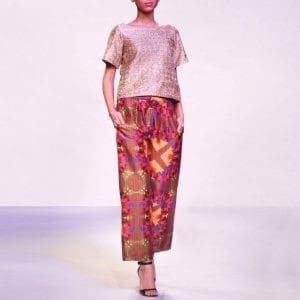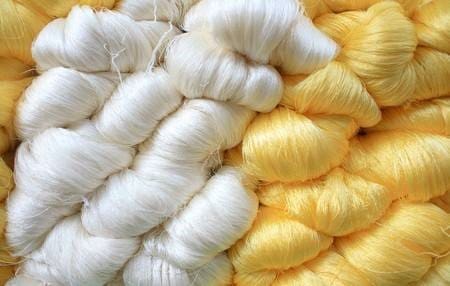- Introduction
Silk comes by raising caterpillars (larvae), especially of domesticated silkworm named ‘Bombyx Mori’. This process of getting silk from silkworm is called as sericulture. The best larvae are taken from the cocoons of silk producing worms and insects. This is then weaved together to form finest and the most delicate form of texture, that has never faded in the popularity through the decades.
The long and colourful history of silk
From decades until present day, silk has not only dominated fashion, but also politics and history. From the ancient Confucian legend of princess Xi Ling Shi, to the resurrection of the ‘Silk Road’. And even now silk continues to have a special allure. For years it has been prized as a fabric for clothing and home furnishings.
Types
There are many types of silks like Mulberry silk, Eri silk, Tussar silk and Muga silk. The silk that contains sericin is known as ‘Raw silk’. The sticky substance, that gives protection during processing is retained until the yarn or fabric stage. Then by boiling the silk in soap and water it is removed which leaves it soft and lustrous and the weight get reduced by 30 percent.
Raw silk is popularly known as ‘Resham’ in Urdu and hindu, in Eastern India it is known as ‘Paats’ and in southern parts of India it is known as ‘Pattu’.
Varieties in raw silk
The fabric has always retained a winning position in the world of fashion. There are different types of raw silk that improves the quality and feel of a garment. Tussar raw silk is of copper colour. It also bears similarities like Tropical Tussar silk. Muga raw silk retains a golden based hue for lifetime that gets generated when it is spun. Mulberry raw silk is considered to be the finest and softest texture of all.
Properties
- Tensile strength- Silk has enormous tensile strength with a breaking load of nearly 5000 kg per cm3 or 4 g per denier. It has an elongation of about 20 per cent of its original length before breaking. The elasticity is relatively less. It can be stretched only one to two per cent before it has a permanent set.
- Density of Silk- Raw silk has a density of 1.33where as degummed silk has a density of 1.25. Although these are the accepted standards of density, it is not absolutely constant for all varieties of silk but within small limits it varies with the breed of cocoons.
- Hygroscopic Nature- Hygroscopic properties of raw silk are commercially very important. Silk is very hygroscopic and is capable of absorbing up to 30 per cent of its weight of moisture, when exposed to saturated conditions of atmosphere without feeling wet or dry. But when bone dry silk is kept for a specified time in a standard atmosphere having 65 per cent humidity at 25ºC, the silk absorbs only 11 percent of its weight if the silk is raw and 10 per cent if it is in degummed condition.
- Electrical Properties- Silk is a poor conductor of electricity and collects a static charge by friction, which at times renders it difficult to handle in the manufacturing process. The charge can be dissipated by high humidity or by maintaining 65 per cent R.H. at 25°C. Owing to its insulating properties silk is extensively used for covering wire in electrical apparatus.
- Action of Water- Water does not permanently affect silk fibre. Its strength decreases about 20 per cent when wet but regains the original strength upon drying. The fibre swells, but does not dissolve when steeped in warm water. Silk is a highly absorbent fibre and readily becomes impregnated with water.
- Action of Acids- Concentrated sulphuric and hydrochloric acids dissolve silk. In strong hydrochloric acid silk is dissolved in one or two minutes. Sulphuric acid takes a much longer time. If silk is treated with strong sulphuric acid for only a few minutes, then rinsed and neutralized, the fibre contracts from 30 to 50 per cent in length and loses its lustre, and no further damage is done. This is taken advantage of in creping of silk fabrics.
- Action of Alkalies- Silk is not sensitive to dilute alkalies, though the lusture of the fibre is somewhat dulled. When treated with strong hot alkalies such as caustic soda or caustic potash, silk fibre dissolves. Ammonia and alkaline soaps dissolve only the sericin layer of silk but have no effect on the fibroin.
- Effect of heat- If white silk is heated in an oven at 110.5ºC for 15 minutes it begins to turn yellow. Above 170ºC silk disintegrates and on burning, it gives out an empyreumatic odour.
- Effect of Light- Silk is sensitive to weakening by ultra violet light. It loses as much as 50 per cent of its strength after six hours exposure to ultra violet light. Scoured silk requires a much shorter time for tendering. Silk in the form of fabric is readily damaged by sunlight.
Maintenance
As it is highly prone to damage, it is always suggested to avoid the risk of sunlight hitting the fabric on a direct basis. Also, one must always keep the garment stain free as that would completely tarnish the look of this fabric. Moreover, it is next to impossible to get rid of the stains without causing any damage to the fabric.
Innovations
In today’s time silk fabrics have spread out their use in neckties, scarves, bags, different apparels, table covers, bedspreads, curtains, cushion covers, etc. Nowadays, silk is also used over carpets and many other home décor purposes.

Raw silk scarf

Raw silk clutch with embroidery

Dupion silk top and raw silk trouser

Raw silk saree
Appropriateness
Be it marriage ceremonies, religious functions and other traditional get togethers, this fabric has the capability of getting well into any environment, regardless of season. Most of the times young brides adorn this fabric which makes the look even more royal and grandeur.
Accessorizing
As these fabrics are mainly chosen for wedding sarees, heavily plated gold, diamond and pearl jewellery bear the capability of complimenting the silky attire to a great extent.
Global use
Earning to the popularity, recognition and fame this fabric has owned throughout all the decades, for its never-ending comfort millions of people across globe have found their attraction and interest towards this fabric.
Thankyou
Article by- Sneha Savla



